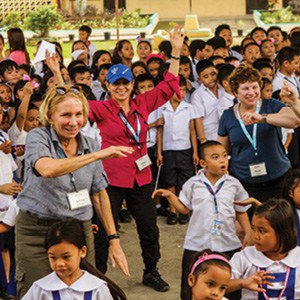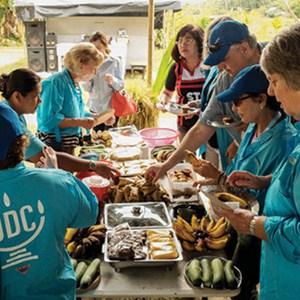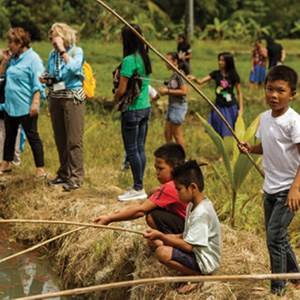This is an open thank you letter to our community, the Tidewater Jewish community, for its unwavering support and care for Jewish communities around the world. This care takes into account our strong values of tikkun olam, the concept of leaving the world a better place than we found it, the responsibility for “repairing the world.” Our organized Jewish community does this work through its partnership with the JDC, the American Jewish Joint Distribution Committee, also known as The Joint.
The JDC was founded in 1914, during World War I, as the first Jewish organization in the United States to dispense large scale funding for international relief. Henry Morgenthau, the U.S. Ambassador to Turkey, made an emergency call to Jacob Schiff in New York requesting a one-time gift of $50,000 for the Jews living in Palestine who were suffering from extreme poverty. It was important to Ambassador Morgenthau that the money be raised and that there were boots on the ground to spend it wisely and effectively.
 In all of Jewish history up to this point, there had never been one address to which Jews in need, no matter where they lived, could turn for assistance. Never, in the long history of our people, has one organization maintained the same fundamental mission that informed its founding for so long and has not only NOT been weakened over time, but has grown from strength to strength. That is the JDC.
In all of Jewish history up to this point, there had never been one address to which Jews in need, no matter where they lived, could turn for assistance. Never, in the long history of our people, has one organization maintained the same fundamental mission that informed its founding for so long and has not only NOT been weakened over time, but has grown from strength to strength. That is the JDC.
That one-time gift turned into 105 years of life saving work around the world. JDC played a pivotal role in sustaining Jews in Palestine and rebuilding the devastated Jewish communities of Eastern Europe. 
In 1945, by the end of World War II, tens of thousands of newly liberated Jewish survivors, 75,000, were crammed into JDC Displaced Persons Camps hastily set up in Germany, Austria, and Italy. Conditions were unimaginable and anti-Semitism was prevalent. By mid-1947, the numbers had grown to 250,000 Jewish survivors.
At this time, Earl Harrison, dean of the University of Pennsylvania Law School and President Harry Truman’s Special Envoy, asked Joseph Schwartz, JDC’s European director, to accompany him on an official tour of the DP Camps. The Harrison Report called for separate Jewish camps and for the United Nations Relief and Rehabilitation Administration to administer to them with the JDC’s help. Joseph Schwartz virtually recreated JDC by putting together a field organization that covered Europe, and later, North Africa, and by designing an operational strategy that valued action, initiative, and outcome.
 This strategy holds true today—only in a much more complicated world. For many years, JDC identified itself by the 3 R’s: Relief, Renewal, and Resettlement. Although resettlement has fallen off dramatically in the last several years, the other two Rs are working overtime.
This strategy holds true today—only in a much more complicated world. For many years, JDC identified itself by the 3 R’s: Relief, Renewal, and Resettlement. Although resettlement has fallen off dramatically in the last several years, the other two Rs are working overtime.
This is remarkable history and there’s so much more. Our community, the Tidewater Jewish community, owns this history.
I honestly believe that every time we respond Jewishly to a need or a crisis, we create a piece of Jewish history. Our community has always responded!!! We have never sat on the sidelines as observers of Jewish life and Jewish history.
JDC quietly performed non-sectarian work around the world until the Rwanda genocide in 1994. In an unprecedented move at the time, JDC placed a full-page ad in the New York Times to solicit aid for Rwanda refugees. The results were astonishing. More than $2 million in checks were received by the New York office. This campaign started the open mailbox initiative JDC established to respond to worldwide humanitarian crisis.
GRID—Global Response & Innovative Development—is JDC’s premier disaster relief effort that has helped more than 60 countries in crisis, utilizing Israeli innovations and expertise to advance sustainable development goals.
Following Rwanda, JDC quickly responded to other disasters around the world.
- Haiti, January 2010: After the earthquake, JDC set up the first medical tent in partnership with the Israeli IDF and delivered the first baby. JDC’s work in Haiti was featured by CNN.
- Japan, March 2011: The Great East Japan Earthquake triggered a tsunami. JDC was the only aid organization Japan admitted for aid work.
- Nepal, April 25, 2015: 9,000 dead, an entire community destroyed.
- Philippines, November 8, 2015: Typhoon Haiyan, nearly 7,000 people were killed, 5 million people lost both their homes and livelihood in one day.
 The Jewish world immediately mobilized to respond. This is who we are.
The Jewish world immediately mobilized to respond. This is who we are.
It was with this as a backdrop that I participated on a JDC Study Mission to the Philippines in January. For more than four years I had heard about the devastation to the Philippines and the amazing recovery work taking place.
JDC had raised $3 million in its open mailbox campaign and was coming to the end of its five-year plan of recovery and resilience work. Our small group went to access JDC’s partnership strategies in relief and recovery, as well as the impact of its collaboration with the Jewish Association of the Philippines on the Jewish community.
Have you ever vacationed in Hawaii?
It’s a beautiful state with seven inhabited islands containing about one million people with one of the highest per capita incomes in the world. It is often racked by volcanoes and storms.
Now, imagine 750 inhabited islands with 100 million people in one of the poorest places in the world—where the earthquakes, volcanoes, and typhoons are of unimaginable magnitude and the resources of the local government are miniscule. This should give you a mental image of disaster recovery work in the Philippines. With this in mind, we were warmly greeted by the Jewish community of Manila.
We arrived on a Friday afternoon and attended Shabbat services at Beit Yaacov Manila Synagogue. The Orthodox Sephardic synagogue is a beautiful stand-alone that houses a large function room, spacious kitchen, a library, classrooms, a mikvah, and offices. The myriad of activities for the 150 families who comprise the community is hard to imagine. Our group was hosted in different community members’ homes, which gave us an opportunity to learn more about their personal lives. The community is a mix of Americans who do business throughout Asia—some of whom were introduced to the Philippines during R & R from the Vietnam War, Israelis who have come for several years to set up businesses, and a number of Filipino born women who have converted to Judaism and seem to be the mainstay of the community.
The Philippine community takes great pride in the fact that during the Holocaust they were allowed to bring up to 1,300 Jews to their country, thereby saving them. They printed a stamp commemorating this deeply felt achievement. The Philippines was also the deciding vote for Israel’s statehood in 1947—the only Asian country who voted for Resolution 181.
The following three days were spent visiting a variety of projects built and developed by JDC in collaboration with 19 partner aid organizations, the U.S. State Department, USAID, UNICEF, the Israel Trauma Coalition, and the IIRR- the International Institute for Rural Reconstruction, to name a few.
Our study questions were:
• How can disaster recovery programs best promote economic and social development? and
• What is the role of education in emergency response and recovery?
For this we flew to Roxas City on Panay Island. We were greeted at Mambusao Elementary School by 850 smiling, ridiculously excited children. They had made banners and orchestrated a song and dance performance to say thank you to JDC who helped keep a couple of classrooms open during the initial recovery period to dispense food, water, and psycho-social support—which the community was being educated in. During the reconstruction and repair of the school, JDC built additional classrooms for the students. In this part of the world, it’s amazing how little can go so far!
In Roxas, we also studied community resilience and livelihood diversification, where most of the community are farmers. When your entire crop is wiped out, fields flooded, seed reserves demolished with nothing left to replant, what do you do to feed your family? JDC, in partnership with International Institute of Rural Reconstruction (IIRR), gave small loans to the farmers to purchase seeds, restock small ponds they had dug to grow fish in, and purchase an Israeli rice drying machine that helped dry and replenish their rice reserves.
What I experienced during these few days was the strength of the human spirit to overcome unbearable loss—of family and community members, property, and livelihood. JDC worked intensely to teach the farmers how to alleviate the impact of future disasters by diversifying livelihoods and integrating climate smart agriculture techniques. JDC’s partnership with IIRR is strengthening agriculture and fisheries, food security, and entrepreneurship for women and men. This is a holistic way for farmers to approach their future and develop their food sources for years to come.
The beautiful reception the community prepared for us was actually a show and tell of how far they had come and what they were able to accomplish with new techniques in sustainability. The farm collective we visited was overseen by Juan who was trained as an engineer. Juan had developed irrigation levies to withstand flooding, designated areas for different organic crops, built composting centers, and rebuilt the Israeli drying machine for reestablishing the community seed banks.
From the farm, we took part in a workshop that introduced us to psychosocial training with local healthcare workers who provided assistance to those impacted by Typhoon Haiyan. In order to promote long-term sustainability in Filipino communities, JDC has created a cadre of local psychosocial trainers who are training and supporting local professionals working in Disaster Risk Reduction and Management. Local leaders and professionals understand that this training is a critical element of helping their communities mitigate future crises.
Upon arrival in Manila, my immediate questions were: What does disaster response and preparedness look like in an urban context? And, how does this impact the cycle of poverty in the area? By the end of the trip, I was astonished by how far the communities had come and how much impact a small Jewish community of 150 families in partnership with JDC and 19 additional aid organizations can have. It’s truly remarkable!!!
As JDC begins to wrap up its five-year commitment in assisting the Filipino community get back on its feet and plan for its future, I am continually thankful that I come from a community, the Tidewater Jewish community, that is deeply rooted in the value of tikkun olam.
The American Jewish Joint Distribution Committee, the JDC, has won the Israel Prize and is the ONLY recipient agency our Federation is involved with who received a 100% rating for Accountability and Transparency from Charity Navigator.
Which brings me back to my thank you…I thank our community for truly being a “Light unto the Nations” and enriching so many lives around the world while enriching our home community.
Annie Sandler

